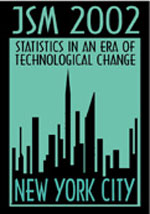|
Activity Number:
|
264
|
|
Type:
|
Invited
|
|
Date/Time:
|
Wednesday, August 14, 2002 : 8:30 AM to 10:20 AM
|
|
Sponsor:
|
International Indian Statisticial Assoc, Reps. For Young Statisticians
|
| Abstract - #300106 |
|
Title:
|
Simultaneous Hormone Pulse Time and Secretion and Elimination Estimation: An Alternating Metropolis and Diffusion Scheme
|
|
Author(s):
|
Somesh Chattopadhyay*+
|
|
Affiliation(s):
|
Duke University
|
|
Address:
|
ISDS, Box 90251, Durham, North Carolina, 27708-0251, USA
|
|
Keywords:
|
hormonal data ; pulse time detection ; selective smoothing ; Gibbs sampling ; Metropolis algorithm ; diffusion
|
|
Abstract:
|
Hormones are secreted from the neuroendocrine and endocrine glands either in a pulsatile or a continuous manner. A pulse time is the onset of a pulse, which should be reflected by a very rapid increase in the observed concentration level. A clinician would want to estimate the unobserved secretion rates from the hormone concentration in the blood samples. To do so, one needs to incorporate the set of pulse times as a parameter in the model, it being more like a nuisance parameter. A desirable pulse-detection algorithm should produce an initial set of (estimated) pulse times, and a procedure by which to systematically add/remove pulse times, based upon the fit of a model to the data. We have developed an algorithm to simultaneously detect the underlying pulse times and the structural parameters for secretion and elimination; the methods involve extensions of Gibbs sampling and simulated annealing. The pulse time detection component is the result of a selective smoothing algorithm, a nonlinear parabolic PDE whose diffusion coefficient is inversely related to the degree of rapid increase. The application of the methods to a broad range of luteinizing hormone data will be discussed.
|
- The address information is for the authors that have a + after their name.
- Authors who are presenting talks have a * after their name.
Back to the full JSM 2002 program |

